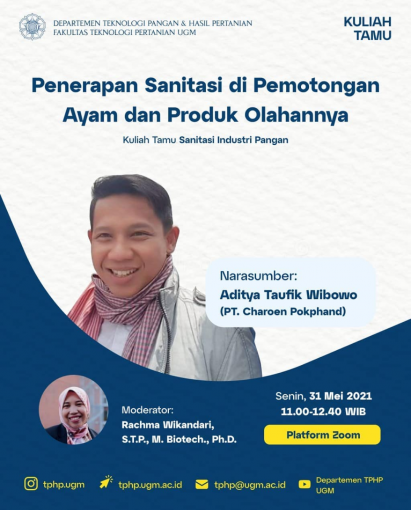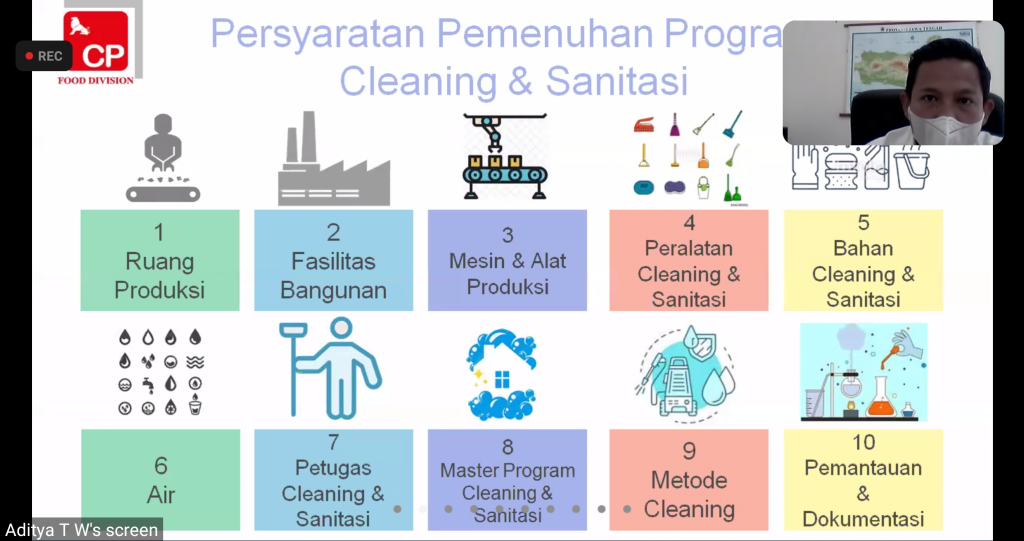
The Food Industry Sanitation course held a guest lecture on Monday, May 31, 2021, at 11:00 – 12:40 WIB. This guest lecture carried a topic on the Application of Sanitation in Chicken Slaughtering and Processed Products with the speaker, Aditya Taufik Wibowo from PT Charoen Pokphand Indonesia and guided by Rachma Wikandari, S.T.P., M.Biotech, Ph.D. as the moderator. This guest lecture was held through the Zoom platform and was attended by 112 participants.
Food is a basic need that must be maintained for the quality of food safety and nutritional value. The goal is that food is beneficial to the body, safe for consumption, and does not pose a health risk. Identification of possible hazards, namely biological (bacteria, fungi), physical (metal flakes, hair, plastic pieces), chemical (antibiotic residues, pesticide residues), and allergens (soy, peanuts, shellfish, wheat, fish, milk, eggs). To protect food from these potential hazards, a quality assurance and food safety system (GMP SSOP and FSSC 22000) is required, including cleaning and sanitizing processes.

Requirements for compliance with the cleaning and sanitation program include production space, building facilities, production machinery and equipment, cleaning and sanitation equipment, cleaning and sanitation materials, water, cleaning and sanitation personnel, master cleaning and sanitation program, cleaning methods, and monitoring and documentation.
In the production room, the division of high-risk and low-risk processing areas is carried out. The high-risk area is intended for the process after cooking and packaging, while the low-risk area is intended for the meat preparation process and before cooking. In the building facilities, materials that are durable, easy to clean, light in color, made of non-toxic materials and do not cause contamination, watertight and resistant to salt, acids, bases, and other chemicals, and smooth and flat surfaces are selected. Then, the meeting between walls, floors, and roofs does not form an angle, and floor slope settings are made.
Machinery and equipment are selected that are safe to use, durable, watertight, anti-rust or corrosion, not made of porous materials (such as wood) and do not absorb chemical compounds, and have flat, smooth surfaces, without sharp corners or areas that can become a place for residual materials and dust. It is also important to select equipment that is easy to clean and maintain in sanitary conditions so that the possibility of contamination does not arise.
In cleaning and sanitizing equipment, equipment identification is carried out according to the area (for high-risk or low-risk areas), sanitary cleaning tools are placed in special areas, the selection of materials does not cause contamination, and is used according to their function. In cleaning and sanitizing materials, the selection of safe and halal chemicals is carried out, equipped with MSDS (Material Safety Data Sheet) including instructions for use available in the production area, food grade (odorless and colorless), placed in closed containers and clearly identifiable, and stored separately from production materials, packaging, and finished products.
Water used in the industry is inspected by an internal laboratory (weekly) and an external laboratory certified by KAN, and there is no cross-connection between the potable water system and the non-potable water system. Cleaning and sanitation workers are given training that includes material on basic understanding of cleaning and sanitation, sanitation cleaning procedures, types of chemicals, chemical handling, making cleaning solutions, as well as uniforms and PPE (Personal Protective Equipment). The cleaning and sanitizing employees’ uniforms are equipped with masks, aprons, work uniforms, hair covers, ear plugs, gloves, and boots.
The master cleaning and sanitation program includes areas and equipment to be cleaned and/or sanitized, job responsibility descriptions, cleaning and sanitation methods, time/frequency, and work instructions. Cleaning methods include cleaning, rinsing, use of cleaning fluids, rinsing again, and sanitizing.
The monitoring stage is carried out visually and in laboratory tests. The visual method is carried out by monitoring the effectiveness of the cleaning and sanitation program according to the frequency. This method is carried out by QC Inspector. Meanwhile, laboratory tests are carried out by product tests and swab tests of production equipment and supplies, employee uniforms, and employees’ hands. This laboratory test is carried out by laboratory staff.
